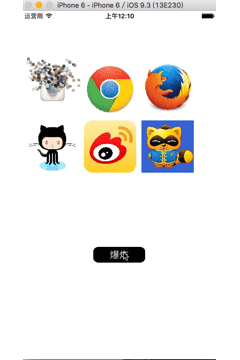在AppStore中的应用越来越重视动画效果的使用,一个良好动画效果可以让两个状态之间平滑地过度,也可以利用动画吸引住用户的眼球,今天我们就来实现一个好玩的动画(破碎动画)!
下面我们来看一下效果图:
( __) 嘻嘻…… 好玩么,下面我们就来实现了哦!
首先我们要创建一个UIView的扩展, 我把它起名叫做UIView + Boom:
#import "UIView+Boom.h"
const static NSInteger cellCount = 17;
static NSMutableArray *booms;
@implementation UIView (Boom)
+(void)load{
booms = [NSMutableArray array];
}
-(void)boom{
[booms removeAllObjects];
for(int i = 0 ; i < cellCount ; i++){
for(int j = 0 ; j < cellCount ; j++){
CGFloat pWidth = MIN(self.frame.size.width, self.frame.size.height)/cellCount;
CALayer *boomCell = [CALayer layer];
boomCell.backgroundColor = [self getPixelColorAtLocation:CGPointMake(i*2, j*2)].CGColor;
boomCell.cornerRadius = pWidth/2;
boomCell.frame = CGRectMake(i*pWidth, j*pWidth, pWidth, pWidth);
[self.layer.superlayer addSublayer:boomCell];
[booms addObject:boomCell];
}
}
//粉碎动画
[self cellAnimation];
//缩放消失
[self scaleOpacityAnimations];
}
- (void)cellAnimation {
for(CALayer *cell in booms){
CAAnimationGroup *animationGroup = [CAAnimationGroup animation];
CAKeyframeAnimation *keyframeAnimation = [CAKeyframeAnimation animationWithKeyPath:@"position"];
keyframeAnimation.path = [self makeRandomPath:cell].CGPath;
keyframeAnimation.fillMode = kCAFillModeForwards;
keyframeAnimation.timingFunction = [CAMediaTimingFunction functionWithName: kCAMediaTimingFunctionEaseOut];
keyframeAnimation.duration = (random()%10) * 0.05 + 0.3;
CABasicAnimation *scale = [CABasicAnimation animationWithKeyPath:@"transform.scale"];
scale.toValue = @([self makeScaleValue]);
scale.duration = keyframeAnimation.duration;
scale.removedOnCompletion = NO;
scale.fillMode = kCAFillModeForwards;
CABasicAnimation *opacity = [CABasicAnimation animationWithKeyPath:@"opacity"];
opacity.fromValue = @1;
opacity.toValue = @0;
opacity.duration = keyframeAnimation.duration;
opacity.removedOnCompletion = NO;
opacity.fillMode = kCAFillModeForwards;
opacity.timingFunction = [CAMediaTimingFunction functionWithName: kCAMediaTimingFunctionEaseOut];
animationGroup.duration = keyframeAnimation.duration;
animationGroup.removedOnCompletion = NO;
animationGroup.fillMode = kCAFillModeForwards;
animationGroup.animations = @[keyframeAnimation,scale,opacity];
animationGroup.delegate = self;
[cell addAnimation:animationGroup forKey: @"moveAnimation"];
}
}
/**
* 绘制粉碎路径
*/
- (UIBezierPath *) makeRandomPath: (CALayer *) alayer {
UIBezierPath *path = [UIBezierPath bezierPath];
[path moveToPoint:self.layer.position];
CGFloat left = -self.layer.frame.size.width * 1.3;
CGFloat maxOffset = 2 * fabs(left);
CGFloat randomNumber = random()%101;
CGFloat endPointX = self.layer.position.x + left + (randomNumber/100) * maxOffset;
CGFloat controlPointOffSetX = self.layer.position.x + (endPointX-self.layer.position.x)/2;
CGFloat controlPointOffSetY = self.layer.position.y - 0.2 * self.layer.frame.size.height - random()%(int)(1.2 * self.layer.frame.size.height);
CGFloat endPointY = self.layer.position.y + self.layer.frame.size.height/2 +random()%(int)(self.layer.frame.size.height/2);
[path addQuadCurveToPoint:CGPointMake(endPointX, endPointY) controlPoint:CGPointMake(controlPointOffSetX, controlPointOffSetY)];
return path;
}
这里呢, 我们要写缩放透明度动画:
- (void)scaleOpacityAnimations {
// 缩放
CABasicAnimation *scaleAnimation = [CABasicAnimation animationWithKeyPath: @"transform.scale"];
scaleAnimation.toValue = @0.01;
scaleAnimation.duration = 0.15;
scaleAnimation.fillMode = kCAFillModeForwards;
// 透明度
CABasicAnimation *opacityAnimation = [CABasicAnimation animationWithKeyPath: @"opacity"];
opacityAnimation.fromValue = @1;
opacityAnimation.toValue = @0;
opacityAnimation.duration = 0.15;
opacityAnimation.fillMode = kCAFillModeForwards;
[self.layer addAnimation: scaleAnimation forKey: @"lscale"];
[self.layer addAnimation: opacityAnimation forKey: @"lopacity"];
self.layer.opacity = 0;
}
- (CGFloat)makeScaleValue {
return 1 - 0.7 * (random()%101 - 50)/50;
}
- (UIImage *)snapShot {
//根据视图size开始图片上下文
UIGraphicsBeginImageContext(self.frame.size);
//提供视图当前图文
[self.layer renderInContext:UIGraphicsGetCurrentContext()];
//获取视图当前图片
UIImage *image = UIGraphicsGetImageFromCurrentImageContext();
//关闭图片上下文
UIGraphicsEndImageContext();
return image;
}
在这里, 我要说些细节知识:
/*
* data 指被渲染的内存区域 ,这个内存区域大小应该为(bytesPerRow * height)个字节,如果对绘制操作被渲染的内存区域并无特别的要求,那么刻意传NULL
* width 指被渲染内存区域的宽度
* height 指被渲染内存区域的高度
* bitsPerComponent 指被渲染内存区域中组件在屏幕每个像素点上需要使用的bits位,举例来说,如果使用32-bit像素和RGB格式,那么RGBA颜色格式中每个组件在屏幕每一个像素点需要使用的bits位就是为 32/4 = 8
* bytesPerRow 指被渲染区域中每行所使用的bytes位数
* space 指被渲染内存区域的“位图上下文”
* bitmapInfo 指被渲染内存区域的“视图”是否包含一个alpha(透视)通道以及每一个像素点对应的位置,除此之外还可以指定组件是浮点值还是整数值
CGBitmapContextCreate(void * __nullable data,
size_t width,
size_t height,
size_t bitsPerComponent,
size_t bytesPerRow,
CGColorSpaceRef __nullable space,
uint32_t bitmapInfo)
*/
接下来的, 就在代码里看注释就好了:
- (CGContextRef) createARGBBitmapContextFromImage:(CGImageRef) inImage {
CGContextRef context = NULL;
CGColorSpaceRef colorSpace;
//内存空间的指针,该内存空间的大小等于图像使用RGB通道所占用的字节数
void *bitmapData;
unsigned long bitmapByteCount;
unsigned long bitmapBytePerRow;
size_t pixelsWide = CGImageGetWidth(inImage);//获取横向的像素点的个数
size_t pixelsHeight = CGImageGetHeight(inImage);
//每一行的像素点占用的字节数,每个像素点的ARGB四个通道各占8个bit(0-255)的空间
bitmapBytePerRow = pixelsWide * 4;
//计算整张图占用的字节数
bitmapByteCount = bitmapBytePerRow * pixelsHeight;
//创建依赖于设备的RGB通道
colorSpace = CGColorSpaceCreateDeviceRGB();
//分配足够容纳图片字节数的内存空间
bitmapData = malloc(bitmapByteCount);
//创建CoreGraphic的图形上下文,该上下文描述了bitmaData指向的内存空间需要绘制的图像的一些绘制参数
context = CGBitmapContextCreate(bitmapData, pixelsWide, pixelsHeight, 8, bitmapBytePerRow, colorSpace, kCGImageAlphaPremultipliedFirst);
//Core Foundation中通过含有Create、Alloc的方法名字创建的指针,需要使用CFRelease()函数释放
CGColorSpaceRelease(colorSpace);
return context;
}
/**
* 根据点,取得对应颜色
* point 坐标点
* @return 颜色
*/
- (UIColor *)getPixelColorAtLocation:(CGPoint)point {
//拿到放大后的图片
CGImageRef inImage = [self scaleImageToSize:CGSizeMake(cellCount*2, cellCount*2)].CGImage;
//使用上面的方法(createARGBBitmapContextFromImage:)创建上下文
CGContextRef cgctx = [self createARGBBitmapContextFromImage:inImage];
//图片的宽高
size_t w = CGImageGetWidth(inImage);
size_t h = CGImageGetHeight(inImage);
//rect
CGRect rect = CGRectMake(0, 0, w, h);
//将目标图像绘制到指定的上下文,实际为上下文内的bitmapData。
CGContextDrawImage(cgctx, rect, inImage);
//取色
unsigned char *bitmapData = CGBitmapContextGetData(cgctx);
int pixelInfo = 4*((w*round(point.y))+round(point.x));
CGFloat a = bitmapData[pixelInfo]/255.0;
CGFloat r = bitmapData[pixelInfo+1]/255.0;
CGFloat g = bitmapData[pixelInfo+2]/255.0;
CGFloat b = bitmapData[pixelInfo+3]/255.0;
//释放上面的函数创建的上下文
CGContextRelease(cgctx);
return [UIColor colorWithRed:r green:g blue:b alpha:a];
}
/**
* 缩放图片
*
* @param size 缩放大小
*
* @return 图片
*/
- (UIImage *)scaleImageToSize:(CGSize)size {
UIGraphicsBeginImageContext(size);
[[self snapShot] drawInRect:CGRectMake(0, 0, size.width, size.height)];
UIImage *res = UIGraphicsGetImageFromCurrentImageContext();
UIGraphicsEndImageContext();
return res;
}
写到这里我们UIView的拓展就写完了呢, 要到VC里调用了哦!这里需要用到多线程GCD:
#我们要创建几张图片, 然后写一个Button来点击控制动画效果呢!#
#这里就不多说了, 下面来说一下多线程GCD#
-(void)GCDMethod:(UIView *)myView afterTime:(NSTimeInterval)interval{
dispatch_after(dispatch_time(DISPATCH_TIME_NOW, (int64_t)(interval * NSEC_PER_SEC)), dispatch_get_main_queue(), ^{
[myView boom];
});
}
